

Recently Posted RNA-Seq Jobs. Affymetrix’s CEO Discusses Array Results vs RNA-Seq. Affymetrix CEO, Kevin King, remarked about the role microarrays continue to play despite the advancement of new sequencing technologies, such as RNA-Seq, during their recent Q1 2011 earnings call.
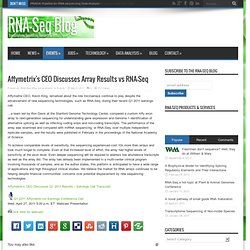
…a team led by Ron Davis at the Stanford Genome Technology Center, compared a custom Affy exon array to next-generation sequencing for understanding gene expression and Genome 1 identification of alternative splicing as well as infecting coding snips and non-coding transcripts. The performance of the array was examined and compared with miRNA sequencing, or RNA-Seq, over multiple independent replicate samples, and the results were published in February in the proceedings of the National Academy of Science. To achieve comparable levels of sensitivity, the sequencing experienced cost 10x more than arrays and took much longer to complete. Even at that increased level of effort, the array had higher levels of sensitivity at the exon level.
Paired-end RNA-Seq provides more accurate isoform abundance estimates than single end sequencing. Recently, ultra high-throughput sequencing of RNA (RNA-Seq) has been developed as an approach for analysis of gene expression.
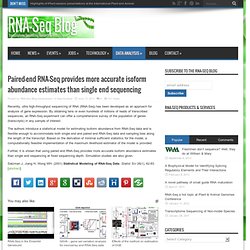
By obtaining tens or even hundreds of millions of reads of transcribed sequences, an RNA-Seq experiment can offer a comprehensive survey of the population of genes (transcripts) in any sample of interest. The authors introduce a statistical model for estimating isoform abundance from RNA-Seq data and is flexible enough to accommodate both single end and paired end RNA-Seq data and sampling bias along the length of the transcript. Transcriptome Sequencing of the Chickpea (Cicer arietinum) Chickpea is an important food legume crop but lags in the availability of genomic resources.
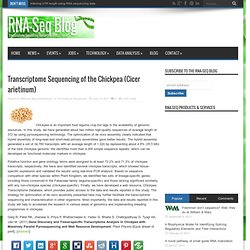
In this study, we have generated about two million high-quality sequences of average length of 372 bp using pyrosequencing technology. The optimization of de novo assembly clearly indicated that hybrid assembly of long-read and short-read primary assemblies gave better results. Removal of rRNA for prokaryotic RNA-Seq. Next-generation sequencing has great potential for application in bacterial transcriptomics.

However, unlike eukaryotes, bacteria have no clear mechanism to select mRNAs over rRNAs; therefore, rRNA removal is a critical step in sequencing-based transcriptomics. Duplex-specific nuclease (DSN) is an enzyme that, at high temperatures, degrades duplex DNA in preference to single-stranded DNA. DSN treatment has been successfully used to normalize the relative transcript abundance in mRNA-enriched cDNA libraries from eukaryotic organisms. Researchers from the Seoul National University demonstrated the utility of this method to remove rRNA from prokaryotic total RNA by comparing it with the conventional subtractive hybridization (Hyb) method.
Illumina deep sequencing was performed to obtain transcriptomes from Escherichia coli grown under four growth conditions. Seq reveals gene expression and alternative splicing information. SAMMate 2.5 – a GUI tool for isoform quantification and visualization using RNA-seq. ExpEdit: a web server to explore human RNA editing in RNA-Seq experiments. RNA sequencing biases caused by random hexamer priming. Seq answers long-standing question in evolutionary biology. Morphological characters are the result of developmental gene expression.

The identity of a character is ultimately grounded in the gene regulatory network directing development and thus whole-genome gene expression data can provide evidence about character identity. This approach has been successfully used to assess cell-type identity. Researchers at Yale University used RNA-Seq to address a long-standing uncertainty in evolutionary biology, the identity of avian wing digits. Seq identifies the microtubule-interacting transcriptome (MT-RNAs) The Transcriptional Landscape of the Yeast Genome Defined by RNA Sequencing. You Are (regulated by what) You Eat! RNA-Seq reveals plant microRNAs regulating expression in mammals from The Scientist Chen-Yu Zhang, a molecular biologist at Nanjing University in China, hypothesized that exogenous microRNAs, such as those ingested through the consumption of milk, could also be found circulating in the serum of mammals.
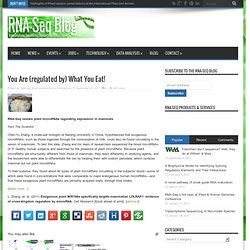
To test this idea, Zhang and his team of researchers sequenced the blood microRNAs of 31 healthy human subjects and searched for the presence of plant microRNAs. Seq for detecting viral agents in wild-caught insects. Mosquito-borne infectious diseases pose a severe threat to public health in many areas of the world.
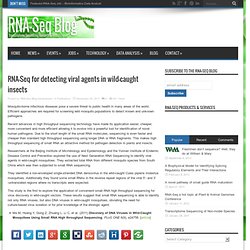
Efficient approaches are required for screening wild mosquito populations to detect known and unknown pathogens. Recent advances in high throughput sequencing technology have made its application easier, cheaper, more convenient and more efficient allowing it to evolve into a powerful tool for identification of novel human pathogens. Due to the short length of the small RNA molecules, sequencing is even faster and cheaper than standard high throughput sequencing using longer DNA or RNA fragments. This makes high throughput sequencing of small RNA an attractive method for pathogen detection in plants and insects. Researchers at the Beijing Institute of Microbiology and Epidemiology and the Yunnan Institute of Endemic Disease Control and Prevention explored the use of Next Generation RNA Sequencing to identify viral agents in wild-caught mosquitoes. Seq application in Prunus species.
Transcript Detection in RNA-Seq. Virus likely not the cause of melanoma. Several viruses are known to cause cancer, such as human herpes virus 8 in Kaposi sarcoma and human papilloma viruses in cervical cancer.
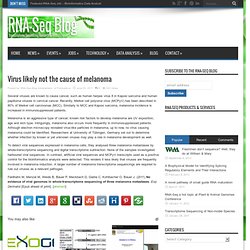
Recently, Merkel cell polyoma virus (MCPyV) has been described in 80% of Merkel cell carcinomas (MCC). Similarly to MCC and Kaposi sarcoma, melanoma incidence is increased in immunosuppressed patients. Melanoma is an aggressive type of cancer; known risk factors to develop melanoma are UV exposition, age and skin type. Intriguingly, melanoma also occurs more frequently in immunosuppressed patients. Although electron microscopy revealed virus-like particles in melanoma, up to now, no virus causing melanoma could be identified.
Designing RNA-Seq Experiments. Randomization For RNA-seq experiments, besides the randomization in preparing the research subjects, there are many other steps to consider for randomization due to the complexity of the technologies.

For example, we can randomize the sample order for various steps in the library construction and the order/location of the samples in the sequencer. Replication. Short read Illumina data for the de novo assembly of a non-model snail species transcriptome (Radix balthica, Basommatophora, Pulmonata) Until recently, read lengths on the Solexa/Illumina system were too short to reliably assemble transcriptomes without a reference sequence, especially for non-model organisms.
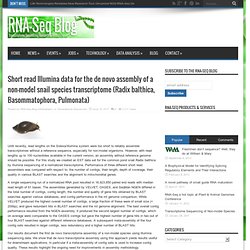
However, with read lengths up to 100 nucleotides available in the current version, an assembly without reference genome should be possible. For this study we created an EST data set for the common pond snail Radix balthica by Illumina sequencing of a normalized transcriptome. Performance of three different short read assemblers was compared with respect to: the number of contigs, their length, depth of coverage, their quality in various BLAST searches and the alignment to mitochondrial genes. A single sequencing run of a normalized RNA pool resulted in 16,923,850 paired end reads with median read length of 61 bases. Moving Next-Gen Sequencing into the Clinic.
The FDA has begun to develop their program to evaluate sequencing based diagnostics. At a recent meeting, the Association for Molecular Pathology (AMP) advised FDA officials on many important considerations for evaluating the analytical validity of next-generation sequencing: The analytical validation requirements for NGS will vary based on the clinical application at issue, such as a mutation panel for a Mendelian disease versus transcriptome analysis.
Performance of, and coverage needs for, a given platform are likely to differ depending on: Advanced RNA-Seq Course. Date: Aug 25-26, 2011 Location: Amsterdam Medical Centre, Amsterdam Organizer: NBIC & LUMC Contact(s): Dr. Celia van Gelder Level: PhD NBIC and LUMC will organize a 2-day course on RNA-seq data analysis on August 25 and 26, 2011. The course will be hosted by Antoine van Kampen at the AMC, Amsterdam. Beginner RNA-Seq Data Analysis Pipeline. Ion Torrent Ships New RNA Sequencing Application. CARLSBAD, Calif., May 31, 2011 /PRNewswire/ — Life Technologies Corporation today announced it is now shipping the Ion Total RNA-Seq Kit for the Ion Personal Genome Machine (PGM™) sequencer, a solution that provides a fast, affordable, easy-to-use alternative to microarrays for transcript expression analysis. The Ion PGM sequencer puts RNA-Seq within the reach of any lab, enabling scientists to get far more accurate and comprehensive data than microarrays can provide for a comparable price.
RNA-Seq has always been the preferred method for studying gene expression because it provides the most complete information, such as transcript quantitation and the detection of novel transcripts and mutations. A high resolution map of a cyanobacterial transcriptome. Previous molecular and mechanistic studies have identified several principles of prokaryotic transcription, but less is known about the global transcriptional architecture of bacterial genomes.
Here we perform a comprehensive study of a cyanobacterial transcriptome, that of Synechococcus elongatus PCC 7942, generated by combining three high-resolution data sets: RNA sequencing, tiling expression microarrays, and RNA polymerase chromatin immunoprecipitation sequencing. We report absolute transcript levels, operon identification, and high-resolution mapping of 5′ and 3′ ends of transcripts. We identify several interesting features at promoters, within transcripts and in terminators relating to transcription initiation, elongation, and termination. Too expensive to fix a leaky cell? Researchers use RNA-Seq and microarray data to show that cells “leak” gene expression and postulate that it may be because shutting down the gene expression completely (fixing the leak) would be more costly to the cell than any deleterious effects or unwanted consequences caused by the leak.
Visual inspection of both microarray and RNA-seq data revealed two overlapping main components of the distribution of gene expression levels which they designate as the lowly expressed (LE) and highly expressed (HE) genes. They further present evidence that the LE genes are expressed rather than simply being experimental background and that the HE genes are functionally active. The transcriptional landscape of Chlamydia pneumonia. Lucigen wins $150K SBIR to develop improved tools for RNA-Seq. How Many Reads are Enough? RNA-Seq at Neuroscience 2011. Illumina RNA Sequencing Webinar Series. Characterization of watermelon transcriptome during fruit development. Reptilian Transcriptome V1.0. WapRNA - a web-based application for the processing of RNA sequences. Pacific Biosciences Lays off 130 Employees. RNA-Seq: Experimental Design, Analysis and Interpretation.
RNA-Seq Poll Results. Characterization of the sesame (Sesamum indicum L.) global transcriptome using Illumina paired-end sequencing. LSCC workshop: RNA-seq Analysis – A Hands-on Introduction. Targeted sequencing Vs Comprehensive RNA-Seq. RNA Assumes More Prominent Role. Introducing the Bioinformatics SCRIPTOME – BioCoders.net. Transcriptome sequencing of a highly salt tolerant mangrove species Sonneratia alba. RNAseq Bioinformatics Short Course Documentation. Effects of Sequencing Depth on Differential Expression. DARIO – a free web service that allows to study short read data from small RNA-seq. Review of RNA-Seq Data Analysis Methods. Transcriptome Sequencing of the Brazilian Water Hyacinth.
Technical variability is too high to ignore. Simple RNA-Seq data analysis with SeqMonk. A novel pathway of small guide RNA maturation. Recent Industry Press. RNA-Seq News… Transcriptome Sequencing of the Manila Clam. Transcriptome sequencing of lentil based on second-generation technology permits large-scale unigene assembly and SSR marker discovery. New study finds RNA-seq data greatly affected by bias and systematic errors. Categorization of Data Analysis Tools. Construction of Normalized RNA-Seq Libraries for Next-Generation Sequencing. Transcriptome Sequencing Demonstrates that Human Papillomavirus Is Not Active in Cutaneous Squamous Cell Carcinoma. Transcriptome Sequencing of the Wine Grape (Vitis vinifera L.). Seq Poll Results.
Bacterial Transcriptomics. Multiplex Analysis of PolyA-linked Sequences (MAPS) ChIP-Seq and RNA-Seq Presentation. RNA-Seq for Gene Finding. RNA-Seq News – from GenomeWeb. Transcriptome Sequencing and De Novo Analysis for Yesso Scallop (Patinopecten yessoensis) Quality of RNA-Seq Data. Genome Annotation with RNA-Seq. The Impact of Protocol on Next-Gen Sequencing Based Gene Expression Analysis.
ENGAGE RNA-seq Course. Determining Standards for RNA-Seq Data Analysis: Biological Interpretation. Improving RNA-Seq expression estimates by correcting for fragment bias. Uncovering the Complexity of Transcriptomes with RNA-Seq. Industry Press. RNA-Seq revealing transcriptomes of commercially important marine species. A pipeline for RNA-seq data processing and quality assessment.